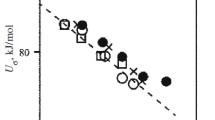Summary
This paper aims at a quantitative theory of power absorption in polymeric solids. The theory is based on two principles: the dislocation theory of internal stresses and the fluctuation-dissipation theorem. The latter connects, when applied to shear, the spontaneous shear fluctuations of the body with the relaxation strength of the material. The spontaneous shear fluctuations are caused by fluctuating internal strains which can be attributed to fluctuations in the density of dislocation dipoles. A definition is given of the mechanical dipole moment of a group of atoms, which can shift to and between two equilibrium positions, which is analogous to the definition of dislocation dipoles in the continuum mechanics. The theory is applied to cyclohexyl containing polymers, which have been investigated byHeijboer. The values of the mechanical dipole moment of the cyclohexyl ring found on a large number of cyclohexyl ring-containing polymers, all lie in a narrow range which is in agreement with the hypothetical value.
Zusammenfassung
Die Arbeit beabsichtigt eine quantitative Theorie der Energie-Dissipation in polymeren Festkörpern. Die grundlegenden Prinzipien sind zweierlei: die Kontinuumtheorie der Versetzungen und Eigenspannungen und das Fluktuation-Dissipation-Theorem. Letzteres, wenn angewendet auf die Scherung eines Festkörpers, verbindet die spontanen Scherfluktuationen des Körpers mit dem Vermögen des Materials, Energie zu dissipieren. Die spontanen Scherfluktuationen werden verursacht durch Fluktuationen in der Dichte von Versetzungsdipolen. Eine Definition wird gegeben für das mechanische Dipolmoment einer Gruppe von Atomen, die zwischen zwei Gleichgewichtslagen hin- und herhüpfen können, welche analog ist der Definition der Versetzungsdipole im Kontinuum. Die Theorie wird angewendet auf eine Gruppe von Polymeren, die gesÄttigte Sechsringe enthalten. Diese Stoffe sind eingehend vonHeijboer untersucht worden. Die Werte für das mechanische Dipolmoment der Sechsringe, die aus den Messungen vonHeijboer hervorgehen, stimmen unter sich und mit dem hypothetischen Wert überein.
Similar content being viewed by others
References
MacCrum, Read andWilliams, Anelastic and dielectric effects in polymeric solids. (New York, 1967).
Scherr, H., W. Pechhold andB. Blasenbrey. Kolloid-Z. u. Z. Polymere238, 396 (1970). -Hägele, P. C. andW. Pechhold, Kolloid-Z. u. Z. Polymere241, 977 (1970).
Kröner, E., Kontinuumtheorie der Versetzungen und Eigenspannungen, Ergebnisse der Angewandten Mathematik (Berlin-Heidelberg-New York 1958).
Encyclopedia of Physics, Vol. III/2, page 510.
Heijboer, J., Mechanical properties of glassy polymers containing saturated rings. (Delft 1972). -T. N. O. Central Laboratory, Communication No. 435, (Delft - Netherlands).
Kroupa, F., Phil. Mag.7, 783 (1962).
Author information
Authors and Affiliations
Additional information
With 9 tables
Rights and permissions
About this article
Cite this article
Gisolf, J.H. Mechanical-dipole relaxation in polymers. Colloid & Polymer Sci 253, 185–192 (1975). https://doi.org/10.1007/BF01470228
Received:
Issue Date:
DOI: https://doi.org/10.1007/BF01470228



